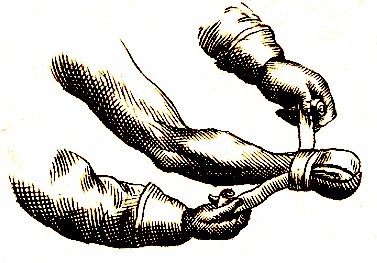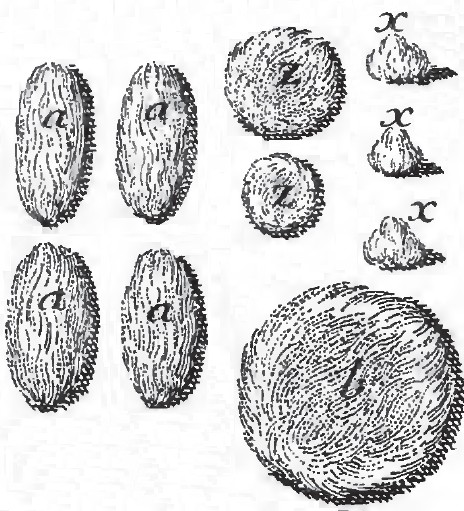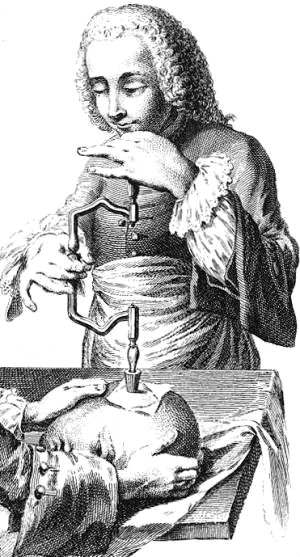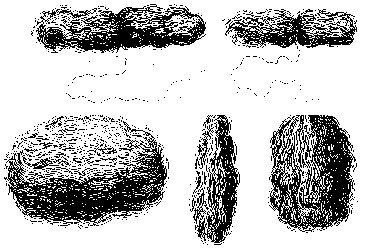
Wound Dressings Page Menu: 1 2 3 4 5 6 7 8 9 10 11 Next>>
Wound Dressings in the Golden Age of Piracy, Page 5
Pledgets in Surgery
As noted on the previous page, pledgets can be found being applied to wounds after nearly every kind of skin penetrating surgical procedure that was performed. However, there were a couple of operations of particular interest which our golden age of piracy surgical authors discuss.
Pledgets in Surgery: Amputation

Dressing an Amputation, The Chyrurgeons Storehouse,
by Johannes Scultetus, Table 28,p. 70 (1653)
Pledgets were an important part of the amputation process. John Atkins advises that material for the operation be laid out in three dishes, "the second, [containing] a Lint-Pledget or two [see the pledgets marked z and x in the drawing below, half a Score others made of soft Tow [a coarse material combed out of flax or hemp fiber - see the pledgets marked a in the drawing below], and different Sizes, and with them a large round one, called a Cap, spread with some astringent Mass to cover the rest see the pledget marked b in the drawing below]"1.
Likewise, sea surgeon John Woodall recommends the preparation of "plegents of tow greater & smaller, dorssels, and buttons of tow"2. Dionis adds that the surgeon should have "double the number of Pledgets, Astringents and Bolsters, that nothing may be wanting; and all this requiring Time 'tis done out of the Patient's Presence, that he may not be terrified at the sight of so much Lint, and so many Bolster and Bands."3
John Woodall advises the use of pledgets in amputation primarily to stop the bleeding. First he tells the surgeon to use "buttons of towe [like the plegets marked x in the drawing below] some foure or five, wet them in the strong restrictive [medication to stop bleeding] to be laid on the great ends of the Vaines and Arteries when they are absized"4.He further recommends having "one plegent made no bigger then the end of the member [which has been amputated]; let it be spred with this recited strong Restrictive, mixed with an egge and a little vineger, which done, strew it thicke with some of the said stronger powder mentioned [b]"5. On top of that he puts another pledget "spred with the ordinary restrictive mentioned and mixed with an egge as the former."6

Bandaging materials taken from A course of chirurgical operations,
2nd ed,
by Pierre Dionis, p. 403
Sea surgeon John Moyle also uses pledgets extensively in his treatment of the stump following the amputation of the infected part. In addition to telling the surgeon to use tow pledgets on which he must "sprinkle some Pulv. restringens [powdered medicine to stop bleeding] on the mouths of the Vessels [z at right]"7. Moyle also advises the surgeon to "apply small Pledgits of Tow thereon... on the bone; apply still a Plegit of Tow with Pouder of Myrrh. (Some use dry Tow all along)."8 He also recommends the surgeon "apply several Pledgits [b at right] armed with your Digestiv. Opt. as at No. 6. [Moyle's prescription for a medicine to encourage the formation of pus] all over the end of the stump, and on them a double Bolster."9
John Atkins gives a similar procedure, although he uses the ever-popular wound cleanser turpentine (Ol. Terebinth. He explains his reasoning quite extensively and vividly. "The Ends of the Bone are to be covered according to Custom, with dry Lint, (sicca siccis gaudent;) and to the Artery we apply thick round Pledgets dipped in warm Ol. Terebinth. one on another [z], to render it still the securer; for as that will be the deepest Part of the Stump where the Artery is, so without this Caution of raising it at least to a Smoothness, the Compression in Rowling would be least where it is most wanted: The rest of the Stump also, we cover with an answerable Number of Pledgets pressed out of the same [like z and a]"10 Thus, according to Atkins, the pledgets served to deliver the medicine and put pressure on the artery to stop the bleeding.
3 John Atkins, The Navy Surgeon, p. 123-4; 2 John Woodall, the surgions mate, p. 172; 3 Pierre Dionis, A course of chirurgical operations: demonstrated in the royal garden at Paris. 2nd ed., p. 409-10; 4,5,6 John Woodall, the surgions mate, p. 172; 7,8,9 John Moyle, The Sea Chirurgeon, p. 59; 10 John Atkins, The Navy Surgeon, p. 125-6
Pledgets in Surgery: Trepanning

Trepanning, Encyclopédie, ou Dictionnaire raisonné des
sciences,
Volume 2b, Plate 42, p. 121 (1762) Trepanning is the process of drilling a hole in the skull to relieve pressure on the brain. Like amputation, trepanning was referred to at this time as a 'capital' operation because of the high skill level required and the similarly high level of mortality in which the procedure resulted. Many of the surgeons advised the use of pledgets (or dossils) in this operation.
Upon examining a man with a skull fracture, the esteemed military surgeon William Clowes said he "made a sufficient dilatation and raised up the flesh, for that cause I could not at that present time proceed any further, by reason of the great flux of blood, and moreover, for that he lost much blood before he was brought to his lodging, all which being considered, I filled the wound with pledgets and rulets made of lint and very fine tow, wet in the whites of eggs mixed with Galen his powder then with good bolstering and rolling he thus remained until the next day."1
Military surgeon Richard Wiseman suggests their use extensively in trepanning.
Before:
"The Depression was a piece of Bone as broad as a Three-pence sunk under the Scull. I filled up the Opening with Dossils of dry Lint, and applied over all a Digestive ex terebinth [turpentine], & vitell. ovi [egg yolk] upon Pledgits, and empl. é bolo [a plaster of oil, elemental lead, and argillaceous earth], with Bandage to keep them on."2
During:
"If by the Emplaster you discover the Fissure, or that the Bone contuses, you are to rasp the contused Part the whole length: to which purpose you ought to be furnished with various sorts of Raspatories [small files]. Whilst you are working with them, the Lips of the Wound ought to be covered with some soft Linen, that you neither hurt them, nor yet the Air offend them."3

Surgical Manual Author Richard Wiseman
And after:
"He [the patient] had rested ill, and had vomited often, and complained of much pain in that lower Jaw. I took off the Bandage and Emplaster, and drest the Lips of the Wound with a Digestive ex terebinth, &c upon Pledgits dipt in ol. hyperici [St. John's wort] hot, embrocating the Parts about with ol. cham. & ros. [oil of roses and chamomile]"4.
Several other authors also suggest the use of pledgets and bolsters when trepanning5, but we'll close with a suggestion by the author of the first English Sea Surgeon's manual, John Woodall:
"For the second application, have ready of the noble linament of Arceus [a mild stimulant for healing of ulcers – made from elemi resin, turpentine, suet and olive oil] never sufficiently commended, and being somewhat hotter then the partie would willingly beare it, annoint the wound therewith in each place, with a little soft lint on a Probs end, leaving the said lint therein, and with plegents of lint drie fill up the orifice, and after annointing about the edges of the griefe, apply a plaster... Some use therewith also a digestive of Terpintine, and the yolke of an egge well mixed, ana a like quantitie, wherewith they spread plegents, and then dippe them in the warme mell and oyle mentioned, and so apply them, which is very good, and and the most ancient practise in curing of wounds of the head."6
1 William Clowes, Selected Writings of William Clowes, p. 123; 2 Richard Wiseman, Of Wounds, Severall Chirurgicall Treatises, p. 393; 3 Wiseman, p. 380; 4 Wiseman, p. 398; 5 See for example John Moyle, The Sea Chirurgeon, p. 110-4, Moyle, Memoirs: Of many Extraordinary Cures, p. 3-11 & John Atkins, The Navy Surgeon, p. 87; 6 John Woodall, the surgions mate, p. 173
Pledgets in Surgery: Removal

A Last View of Some Pledgets, Encyclopédie, ou Dictionnaire raisonné
des
sciences,
Volume 2b, Plate 2, p. 104 (1762)
Two of our surgeons give advice on how to effectively remove a pledget from a wound. The first is a practical note: "We are not to take off this Dressing in two or three Days, but rather stay longer, if we fear an Hæmorrhage at the Dressing; we gently take off the Pledgets, because the thread of the Ligature may happen to stick to it"1.
The second also gives a practical suggestion, followed by another thought that is rather more curious: "For the greater neatness, take off the Pledgits which have the Pus on them, with your Forceps, to prevent fowling your Hands, which would be offensive to the Bystanders."2
This begs the question: Who are these bystanders who watch a surgeon remove the dressings from a wound that has been bound up for several days?
Next we'll discuss bandaging.
1 Pierre Dionis, A course of chirurgical operations: demonstrated in the royal garden at Paris. 2nd ed., p. 414; 2 Charles Gabriel Le Clerc, A Description of Bandages and Dressings, p. 9

